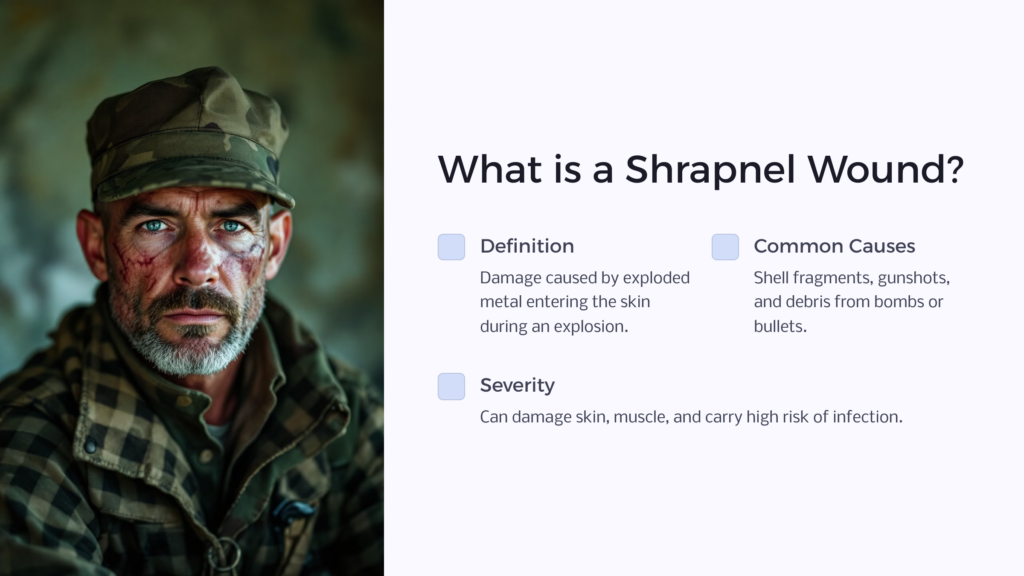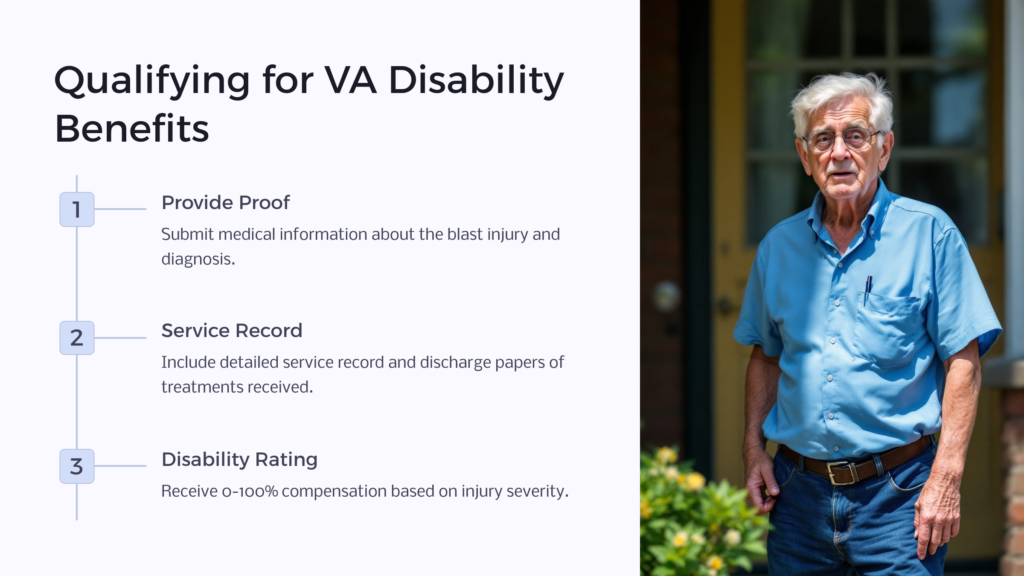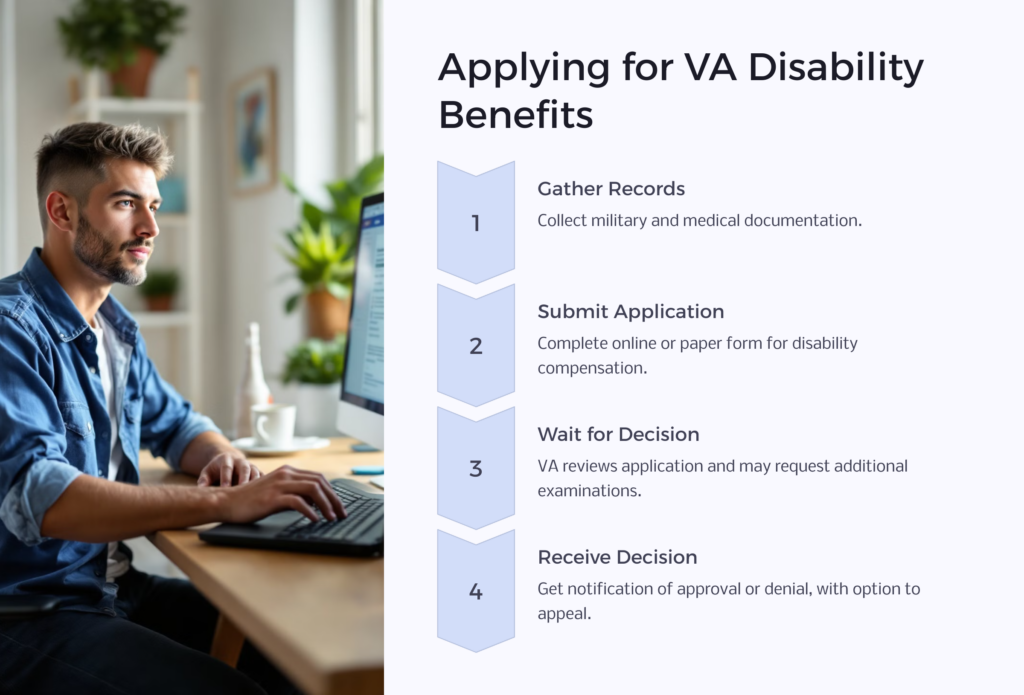If you experienced an injury caused by an explosive during military service, this counts as a shrapnel wound.
Veterans on the frontline of military combat are usually vulnerable to these kinds of injuries.
Although It can be challenging to prove your VA disability claim, you may qualify for benefits through the VA.
What is a Shrapnel Wound?

Shrapnel wounds occur during an explosion when the exploded metal enters a person’s skin and results in damage. The type of debris, or shrapnel, is categorized according to the severity of the damage. Bullets or bombs made with caustic material or pieces of metal, or heavy materials are now used in modern warfare. Debris from shell fragments or gunshots are the most common offenders.
A shell fragment has a high velocity and can damage the skin and muscle. Considering the type of debris entering the body, risk of infection is always high with such a muscle injury. A wound like that would certainly require professional and possibly long-term medical treatment.
VA Benefits for Shrapnel Wounds
Veterans suffering from shrapnel wounds may be eligible for VA disability benefits. The role of VA disability compensation is to provide medical and financial assistance to veterans suffering from a mental, physical, or emotional impairment caused by their military service.
To become eligible for this benefit, veterans must file a claim, provide proof that their muscle injury occurred during their time of active duty, and meet the required eligibility criteria set by the VA.
How do I qualify for VA disability benefits?

Veterans looking to apply for VA disability benefit opportunities must provide proof that their impairments are indeed battlefield injuries. This process includes providing medical information about the blast injury, diagnosis, independent medical opinion (IMO), medical nexus letter, and proof of mental, psychological, or physical limitations.
In addition, veterans must provide a detailed service record and discharge papers of the treatments received. Veterans can receive anywhere from 0-100% disability compensation depending on the seriousness and damage caused by the injury.
How does VA rate Shrapnel wounds?
Shrapnel rating is done according to the amount and severity of disability caused.
The VA categorizes shrapnel wounds as a type of injury that may be eligible for disability compensation if they are service-connected. The VA considers service-connected injuries to be incurred or aggravated during military service, not the result of willful misconduct or caused by a pre-existing condition.
When determining the disability rating for types of shrapnel wounds, the VA will consider the severity of the injury, the impact on the individual’s ability to work and perform daily activities, and any related medical conditions or complications. The VA uses a schedule of ratings that assigns a percentage of disability based on the severity of the injury, ranging from 0% to 100%.
For example, suppose an individual sustained a blast injury that caused limited scarring and did not affect their ability to work or perform daily activities. In that case, they may be assigned a disability rating of 0%. On the other hand, if an individual sustained more severe battlefield injuries that required ongoing medical treatment and impacted their ability to work or perform daily activities, they may be assigned a higher disability rating.
It’s important to note that the specific disability rating assigned to muscle injuries will depend on the individual circumstances of each case, and the VA will consider all relevant medical and service records when determining.
On a general note, a more severe shrapnel injury has a higher rating and compensation. For example, a veteran whose shrapnel wound bed resulted in a traumatic brain injury or disfigurement would qualify for higher shrapnel benefits.
How do I apply for veteran disability benefits relating to shrapnel wounds?

To apply for veteran disability benefits relating to shrapnel wounds, you can follow these steps:
Gather your military and medical records: You will need to provide documentation of your military service, including your discharge or separation papers, as well as any medical records related to your shrapnel wounds.
Complete and submit the Application for Disability Compensation: You can complete the application online through the VA’s eBenefits portal or by filling out a paper form and submitting it by mail or in person at your local VA regional office.
Wait for a decision: The VA will review your application and medical records to determine if your shrapnel wounds are service-connected and if you are eligible for disability compensation. This process can take several months, and you may be asked to attend a medical examination to provide additional evidence.
Receive a decision: Once the VA has decided on your claim, you will receive a notification in the mail. If your claim is approved, you will receive a disability rating that reflects the severity of your disability and determines the amount of compensation you will receive. If your claim is denied, you can appeal the decision.
It may be helpful to seek assistance from a veterans service organization or a qualified attorney who specializes in veterans benefits to help you with the application process and any appeals.
Is it difficult to be approved for benefits relating to shrapnel wounds?

Obtaining benefits relating to shrapnel wounds can be a complex process. It may require submitting detailed documentation of your military service and medical records. However, whether it is difficult to be approved for benefits depends on the individual circumstances of each case.
To be eligible for disability compensation for shrapnel wounds, the VA must determine that the injury is service-connected. This means that the injury must have been incurred or aggravated during military service and was not the result of willful misconduct or caused by a pre-existing condition. If sufficient evidence supports a service connection, it may not be difficult to be approved for benefits.
However, if there is insufficient evidence to support a service connection or the VA document determines that the shrapnel wound is not disabling, it may be more difficult to be approved for benefits. In some cases, the VA may require additional medical examinations or evaluations to determine the extent of the injury and its impact on the individual’s ability to work and perform daily activities.
It’s important to note that the process for obtaining benefits for shrapnel wounds can be time-consuming and may involve several rounds of appeals. Seeking assistance from a veterans service organization or a qualified attorney specializing in veterans benefits can help navigate the process and increase the chances of a successful claim.
How Benefits.com can help
Don’t miss out on the benefits you deserve. Benefits.com is here to help you access the information you need to get the support you need.
With benefits.com, you can access a comprehensive list of benefits available to veterans, including disability compensation, education and training, healthcare, and housing assistance. In addition, our platform is designed to provide the latest information on benefits and how to apply for them.
We understand that navigating the process of accessing benefits can be overwhelming. That’s why we’re here to assist you every step of the way. So contact us today to help you access the benefits you’re entitled to, quickly and easily.
 Benefits.com Advisors
Benefits.com Advisors
With expertise spanning local, state, and federal benefit programs, our team is dedicated to guiding individuals towards the perfect program tailored to their unique circumstances.
Rise to the top with Peak Benefits!
Join our Peak Benefits Newsletter for the latest news, resources, and offers on all things government benefits.



















